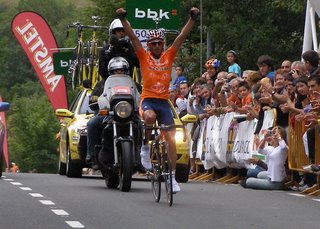Iban Mayo Diez was born in Igorre, a small town in the Basque province of Viscaya, on the 19th. of August 1977. As almost every pro rider, he started cycling early on. In Iban`s case, when he was nine. His talent soon became evident, and as an amateur he joined Banesto. His spell with Banesto didn`t go as planned, as he injured himself badly, and left for Café Baqué after two years. In his second season with the small, yet well known, Spanish te
am, he stood on top of the podium no less than 13 times, and was already then a climbing specialist. At 20 years of age, he decided to go for a career as a professional cyclist, and his impressive record made professional teams very keen to take him one. But he only wanted to join his home team, Euskaltel-Euskadi. He became professional with the Basque outfit in 2000, when he was 22 years old.
In his first year as a pro, Iban didn`t to anything spectacular, but went close to a win once, when he came second on the fourth stage of the GP CCRLVT. Though, in 2001, Iban signalled his arrival with the big-boys. By taking three highly impressive wins, the overall of the Midi Libre, the Classique des Alpes and a stage in the Dauphiné Libéré, pluss many second places and good overall placings, Iban was quickly dubbed "the great orange hope", with "orange" reflecting the colours of Euskaltel. He was the new saviour of Basque cycling.
2002 was the year Iban signalled his potential as a Grand Tour contender, claiming a fifth place overall in the Vuelta a España. His abilities and consistency in the mountains were amazing to say the least, coming from such a young and unexperienced rider. His great Vuelta performance saved an otherwise disappointing season, where injuries played an important role. His knee-problems hampered him and made him unable to race and train as much as he would have liked to. But if fortune had been against him in 2002, 2003 turned out to be the other way around. His 2003 season was nothing short of phenomenal, claiming seven big wins that made him the most exciting and flamboyant rider in the peloton. Three stages and the overall in the Vuelta al Pais Vasco, two stages and second overall in the Dauphiné and a second place in Liège-Bastogne-Liège made him one of the favourites for the Tour de France that year, and he didn`t disappoint. Winning the Alpe d`Huez stage solo two minutes in front of Armstrong, coming home second and third in two other stages and finishing sixth overall was the stuff of champions. He was the symbol of Euskaltel, Basque cycling and was Spanish cycling`s hottest property. Such was the expectations, that he was touted as the great Miguel Indurain`s inheritor.
2004 started out just the way he ended 2003; winning races in commanding fashion. Winning the Subida al Naranco, the Vuelta a Asturias overall and the Clasica Alcobendas made for a great start to his season, which only got better by claiming a second overall placing in the Vuelta al Pais Vasco, and winning the Dauphiné and taking an amazing two stage wins along the way. Especially his TT win up the Ventoux, where he sat a new best time and "tried to kill me" as Armstrong said by taking almost three minutes out of him, was the making of a great champion. His overall win made him one of, if not the, favourite for his season-target, the Tour de France.
The Tour was his for the taking, but he failed tremendously. Calling it a day on the second rest day beacuse of mononucleosis and bad physical and mental state caused by a crash on stage 3, his abandonment signalled a two-year period with bad results and no wins. To try to avoid the same mistake for the 2005 season, Iban opted for a more relaxed approach to the Tour which included fewer races to make him fresh and hungry in July. But it was a complete failure, with Iban languishing to a lowly 60th. overall. Later he abandoned the Vuelta, and a season to forget was finally over. What had happened to Iban? Where was the Iban of 2003 and 2004? Where did his climbing skills go? No one knew, not even himself it seems. The great orange hope had suddenly become an also-ran in the peloton, far from what he was expected to do.
Iban approached the 2006 season with the same goal in mind as always; the Tour. Though, now expextations weren`t that high. Iban Mayo had become the lost son of cycling, the forgotten man, many said. But his team had faith in him, and after encouraging riding in the Vuelta al Pais Vasco and in the Ardennes classics, Iban finally got the win he deserved. The stage victory in the Dauphiné on top of la Toussuire signalled Iban`s revival, and he was now rated as a dark-horse for the Tour. But illness prevented him once again in France, and he abandoned on stage 13. He left many wondering how he could go from heaven to hell in such a short space of time. He could win any race, beat anyone on his day, but then just being a regular cyclist the next day. But even though another failed Tour was hard to take, he bounced back with some style in August. Winning the Vuelta a Burgos and a stage, before winning the Subida Urkiola, showed Iban was once again back to his best. But expectations follow success, and everyone expected a good Vuelta from Iban. But come the Vuelta, Iban was back to his inconsistent best, and was way off the pace. Finishing 35th. in the Vuelta isn`t something to brag about when your name is Iban Mayo, and Iban ended his season there. Another season, with Iban everyhting from brilliant to lacklustre, came to a close.
What the future holds for cycling`s most talented climber is hard to know. But consistency is the key word. If Iban can find his top form, something he did on several occasions this year, be consistent and finally avoid any illness, Iban will be the best in the world. I believe he can, and if that`s the truth, the future looks bright for the orange hope.













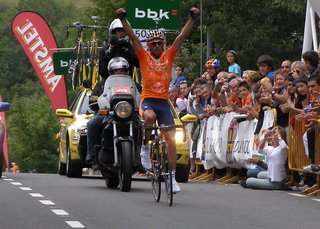






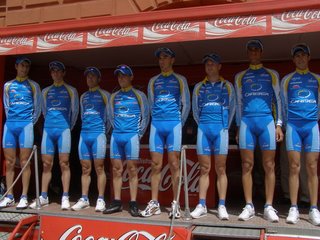












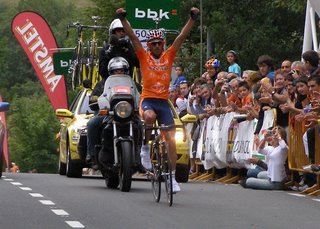




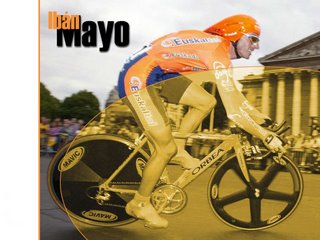







.jpg)
